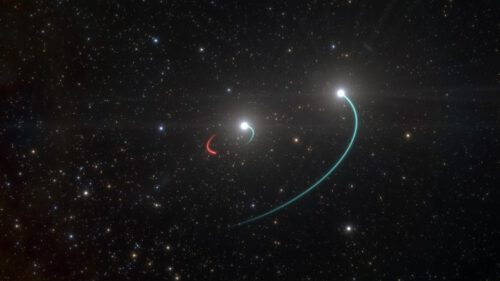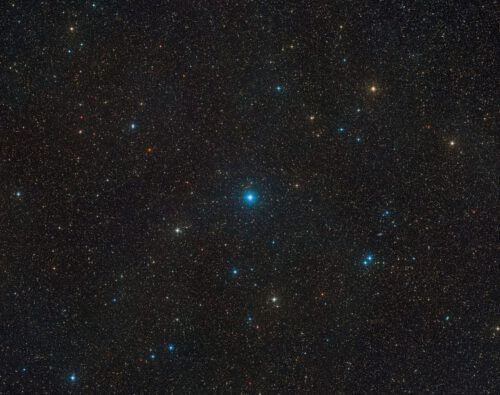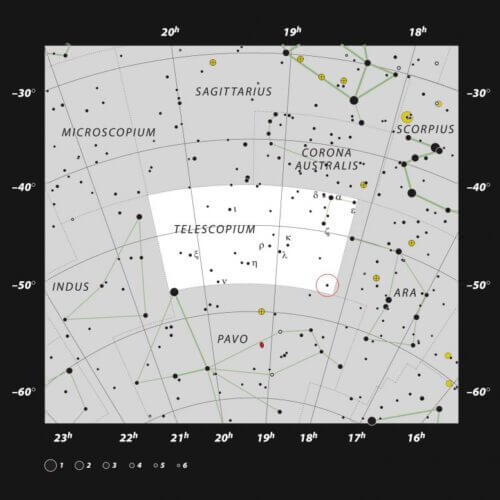Found about a thousand light years from us * An invisible object has two companion stars that are visible to the unaided eye

A team of astronomers from the European Southern Observatory (ESO) and other institutes have discovered a black hole located only 1000 light years from Earth. The black hole is closer to our solar system than any black hole found to date and is part of a triple system that can be seen with the unaided eye. The team found evidence of the invisible object by following its two companion stars with the MPG/ESO 2.20m telescope at ESO's La Cia Observatory in Chile. They say that this system could only be the tip of the iceberg, because it will be possible to find many similar black holes in the future.
"We were completely surprised when we realized that this is the first star system with a black hole that can be seen with the naked eye, without the aid of instruments," says Petr Darba, emeritus scientist at the Academy of Sciences of the Czech Republic in Prague and co-author of the study. The system, located in the constellation Telescopium, is so close to us that its stars can be seen from the Southern Hemisphere on a dark, clear night without binoculars or a telescope. "This system includes the closest black hole to Earth that we know of," says ESO scientist Thomas Rivinius, who led the study published today (May 6, 2020) in the journal Astronomy & Astrophysics.
The team originally observed the system, called HR 6819, as part of a study of binary star systems. But when they analyzed their observations, they were amazed to discover a third, previously undiscovered entity in HR 6819: a black hole. The observations with the FEROS spectrograph on the MPG/ESO 2.20-meter telescope at La Sia showed that one of the two visible stars orbits an invisible object every 40 days, while the other star is at a great distance from this inner pair.
Dietrich Bade, astronomer emeritus at ESO in Gerching and co-author of the study, says: "The observations required to determine the 40-day period had to be spread over several months. This was only possible thanks to ESO's pioneering Service Observations programme, in which observations are made by ESO staff for the scientists who need them."
The hidden black hole in HR 6819 is one of the first stellar black holes found that do not interact violently with their surroundings, so they appear truly black. But the team was able to detect its presence and calculate its mass by investigating the orbit of the star in the inner pair. "An invisible object with a mass at least four times that of the Sun can only be a black hole," concludes Rivinius, who works in Chile.

Astronomers have detected only a few dozen black holes in our galaxy to date, and almost all of them have a strong interaction with their environment and know of their presence because they release strong X-rays in this interaction. But the scientists estimate that during the lifetime of the Milky Way many more stars collapsed into black holes when they ended their lives. The discovery of a silent, invisible black star in HR 6819 provides clues as to where the many black holes in the Milky Way may be. "There must be hundreds of millions of black holes out there, but we only know about a very few. When we know what to look for we will be in a better position to find them", says Rivinius. Bada adds that finding a black hole in such a close triple system indicates that we are only seeing "the tip of an exciting iceberg."
Astronomers already believe that their discovery will shed light on a second system. "We realized that a second system, called LB-1, may also be such a triplet, although we will need more observations to be sure," says Marian Heide, a postdoctoral researcher at ESO and co-author of the paper.
"LB-1 is a bit further from Earth but still quite close in astronomical terms, so that means there are probably many more such systems. If we find and study them, we will be able to learn a lot about the formation and development of these rare stars that begin their lives with a mass that is roughly more than eight times that of the Sun and end them in a supernova explosion that leaves behind a black hole."
The discoveries of these triple systems with an inner pair and a distant star could also provide clues about the violent cosmic mergers that release gravitational waves so powerful that they are observed on Earth. Some astronomers believe that the mergers could happen in systems with a configuration similar to HR 6819 or LB-1, but with the inner pair consisting of two black holes or a black hole and a neutron star. The distant outer object can exert a gravitational influence on the inner pair in such a way that it can cause a merger and the release of gravitational waves. Although HR 6819 and LB-1 have only one black hole and no neutron stars, these systems could help scientists understand how interstellar collisions can occur in three-star systems.

More of the topic in Hayadan:
- A first-of-its-kind photograph of a black hole at the center of a galaxy has been achieved thanks to an international collaboration
- ESO's Giant Telescope in Chile watched the star dance around the supermassive black hole at the center of the Milky Way; Proves that Einstein was right
- The Tess space telescope observed a star engulfed in a black hole

5 תגובות
Nir
A black hole has the same gravitational pull as any star of the same mass.
It is estimated that this black hole is 4-5 times the mass of our sun
(https://en.wikipedia.org/wiki/HR_6819)
When you are not too close to a black hole, there is no difference between it and ordinary stars.
One question, if there is a black hole that is so close to these two stars how exactly does it not suck them in after all they are close enough to be sucked in so how come it doesn't happen??
Very interesting... 1000 light years (as the video on the subject presents it) is considered a relatively large distance considering that there are closer stars. I am lost if in the future we will discover closer black holes that would be able to see their gravitational influence on other suns?
Actually a question. If I'm not mistaken, only recently they managed to "take a real picture" of the accretion disk of another black hole.
Following the passing of a black hole so close, are we expecting more and more impressive "photos"?
Is it possible to identify this hole by the "gravitational lensing" phenomenon that distorts the starlight in its background? Einstein would not rest until an adequate answer was received.